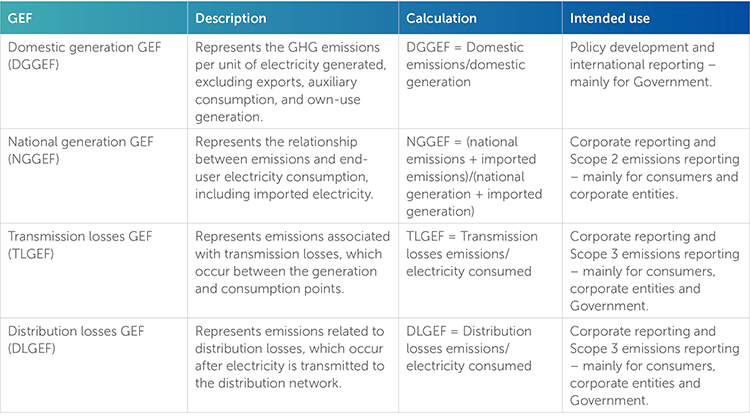Newly released 2022 Grid Emission Factors Report: A guide to accurate emission reporting for electricity usage
At a glance
- The 2022 Grid Emission Factors Report (Report), which was published on 1 November 2024, provides critical data on the carbon intensity of grid-supplied electricity.
- The Report provides updated data on Eskom’s grid emissions factors, enabling companies to accurately report on both their Scope 2 emissions from grid usage and the emissions they avoid through the procurement and use of renewable energy.
- This ensures that emissions disclosures made in terms of Scope 2 and 3 reporting are both transparent and credible.
Environmental, social and governance (ESG) reporting frameworks, including the Greenhouse Gas (GHG) Protocol, generally require companies to disclose both their direct and indirect emissions, thereby providing a means for stakeholders to assess an organisation’s progress in reducing its carbon footprint, and to evaluate its sustainability efforts.
The 2022 Grid Emission Factors Report (Report), which was published on 1 November 2024, provides critical data on the carbon intensity of grid-supplied electricity. This information is invaluable for both organisations and individuals aiming to accurately track and report on their carbon footprint, especially emissions associated with electricity usage.
Understanding grid emission factors
A challenge for many companies in South Africa has been the lack of clear information on the specific emission factors for the emission intensity of Eskom’s grid, making it difficult to assess the true environmental impact of their energy consumption or to quantify the avoided emissions when using renewable sources. The Report (and its predecessor published in February 2024) fills this gap by offering updated data on Eskom’s grid emissions factors (GEFs), enabling companies to accurately report on both their Scope 2 emissions from grid usage and the emissions they avoid through the procurement and use of renewable energy.
According to the GHG Protocol’s Scope 2 Guidance, companies using renewable energy must report on the avoided emissions from fossil fuels associated with grid electricity because it allows them to accurately disclose their environmental impact. Scope 2 emissions refer to indirect emissions from purchased electricity, and when companies reduce their reliance on grid power, they effectively lower their Scope 2 emissions footprint. To ensure transparency, the GHG Protocol recommends that companies quantify and report on the carbon dioxide emissions they avoid by using renewable sources, like rooftop solar, instead of grid power, which is fossil-fuel intensive.
This detailed reporting prevents companies from misrepresenting their sustainability efforts, which could lead to claims of greenwashing. It provides a clear picture of how renewable energy choices contribute to reducing GHG emissions, benefiting stakeholders and supporting companies’ ESG goals.
The 2022 Grid Emission Factors Report explained
A GEF represents the amount of GHG emissions related to electricity usage per kilowatt hour. Four location-based GEFs were developed, with their intended uses being as follows:

The Report also notes significant improvements in South Africa’s carbon intensity, with reductions in the GEFs for both domestic and national electricity generation. Compared to 2021, the domestic generation GEF decreased from 1.013 tCO2e/MWh to 0.960 tCO2e/MWh, largely due to a decrease in coal-based power generation and an increase in renewable sources like solar and wind. This shift reflects ongoing efforts to decarbonise the country’s energy mix in line with its commitments under the Paris Agreement.
Conclusion
The Report enables organisations to calculate their GHG emissions based on reliable, up-to-date data. This ensures that emissions disclosures made in terms of Scope 2 and 3 reporting are both transparent and credible, reducing the risk of misleading claims about environmental performance. Government entities can also leverage GEFs to analyse emission trends, model climate change scenarios, and shape policies for effective climate change mitigation.
The information and material published on this website is provided for general purposes only and does not constitute legal advice. We make every effort to ensure that the content is updated regularly and to offer the most current and accurate information. Please consult one of our lawyers on any specific legal problem or matter. We accept no responsibility for any loss or damage, whether direct or consequential, which may arise from reliance on the information contained in these pages. Please refer to our full terms and conditions. Copyright © 2025 Cliffe Dekker Hofmeyr. All rights reserved. For permission to reproduce an article or publication, please contact us cliffedekkerhofmeyr@cdhlegal.com.
Subscribe
We support our clients’ strategic and operational needs by offering innovative, integrated and high quality thought leadership. To stay up to date on the latest legal developments that may potentially impact your business, subscribe to our alerts, seminar and webinar invitations.
Subscribe




